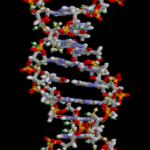What is Genetics?
Genetics is the science of how traits are passed from parents to offspring through genes, which determine everything from physical features to biological functions.
- Genes are segments of DNA that carry instructions for making proteins, which determine traits like eye color, hair texture, and height.
- Every organism has two copies of each gene, one from each parent, which can be dominant or recessive.
- Mendelian Genetics: Gregor Mendel’s experiments with pea plants showed how traits are inherited in predictable patterns (dominant vs. recessive traits).
How Do Genes Work?
Genes work by carrying instructions for building and maintaining cells, and they determine inherited traits through the combination of dominant and recessive alleles.
- DNA: Deoxyribonucleic acid is the molecule that stores genetic information in the form of a code made up of four bases: A, T, C, and G.
- Chromosomes: DNA is packed into chromosomes, and humans have 23 pairs. Each parent passes on one set of 23 to their offspring.
- Alleles: Different versions of a gene are called alleles. For example, the gene for eye color has alleles for blue, brown, and green eyes.
- Punnett Squares: It is a tool to predict possible allele combinations in offspring based on parents’ genes.
Real World Applications
Genetics is crucial in various fields, transforming medicine, agriculture, forensics, and conservation.
Genetic Testing: Helps diagnose genetic disorders and predict health risks.
Gene Therapy: Aims to treat or prevent diseases by altering genes.
DNA Profiling: This is used in criminal investigations to match suspects to evidence found at crime scenes.
Restoration Projects: Genetics guides the breeding of animals and plants for successful reintroduction into the wild.
Genetically Modified Organisms (GMOs): Crops are engineered for better yield, disease resistance, and nutritional value.
Fun Facts
Here are some interesting facts about genetics:
- Humans share about 99.9% of their DNA, but the tiny 0.1% is what makes us unique!
- Surprisingly, humans share about 60% of their DNA with bananas!
- Identical twins have the same genetic makeup, while fraternal twins share about 50% of their genes, just like regular siblings.
- Some people are “super tasters,” which means they have more taste buds and can taste things more intensely due to genetics.
Review
Let’s quickly recap what we learned about the basics of genetics:
- What is the basic unit of heredity? Gene
- What do we call different versions of the same gene? Alleles
- How many chromosomes do humans have? 23 pairs (46 chromosomes)
- What tool is used to predict the genetic traits of offspring? Punnett Square


Recent Comments